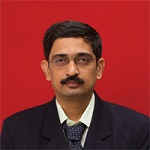Prof. Parag R. Gogate
![]()
Institute of Chemical Technology, India
The research work carried out by Dr. Gogate has concentrated mainly on the cavitational reactors, a novel form of multiphase reactors where the energy input into the reactor is either in the form of fluid kinetic energy or sound energy, which is dissipated in a concentrated form, through the process of cavitation. The theoretical aspects of the work have considered the different approaches to understand the non-linear bubble dynamics including the chemical reactions occurring inside the bubble. This work has resulted into establishing the optimum set of design and operating parameters for maximizing the cavitational effects for acoustic and hydrodynamic cavitation reactors.
A major highlight of the work is the design of pilot scale reactors operating on the basis of multiple frequency multiple transducer ultrasound irradiation based on the theoretical understanding of the bubble dynamics. These reactors have been successfully used for different chemical synthesis and wastewater treatment applications. The energy efficiency and the cavitational yields i.e. yield per unit energy supplied, have been found to be order of magnitude higher as compared to the conventional designs of sonochemical reactors, which did not allow their commercial exploitation earlier.
Dr. Gogate has also investigated the process intensification aspects of different industrially important reactions using cavitational reactors. Among these, the most significant synthesis reactions investigated are synthesis of biodiesel, selective oxidation of sulfoxides and trans-esterification reactions. It has been established and is under demonstration that new designs of cavitational reactors give about 50 to 400% intensification in the rates of reaction as compared to the conventional designs.
Intensification of the sonochemical oxidation has been achieved using solid particles and aeration and the dependency of the optimum conditions of the process intensification on the scale of operation has been conclusively proved. Again these techniques of process intensification of sonochemical reactors have evolved on the basis of the understanding of the cavity nucleation phenomena. Process intensification using hybrid methods i.e. combination of two or more oxidation techniques resulting in synergistic effects has also been investigated on a pilot scale of operation. The combination of cavitation and other advanced oxidation processes have been investigated for wastewater treatment and water disinfection applications and a hybrid treatment strategy possibly useful for Common Effluent Treatment Plants have been proposed.
Dr. Gogate has also done some pioneering work in the area of mechanically agitated contactors to understand the effect of difference in fluid properties on the phenomena of mixing. Again for engineering design, semi empirical correlations have been proposed. One monograph on multiple impeller systems in collaboration withUniversityofGroningen, The Netherlands, has been written as a result of this work.
